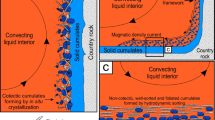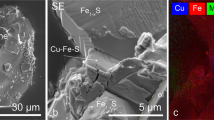Abstract
The mechanisms by which trace and radiogenic elements are held and transported in the Earth's mantle are of prime importance in studies of basalt petrogenesis and the chemical processing of the mantle. While such mechanics include the migration of melts and the convective physical admixture of differentiated material1, the role of fluids as transport agents has attracted much interest, especially, in regions affected by kimberlitic activity2–4, continental basaltic volcanism5,6, and in areas of subduction-related magmatic activity7,8. The observation that many incompatible elements are readily leached from garnet lherzolites by dilute acid treatment3 has led to the assumption that a proportion of these elements is located on grain boundaries, rather than in solution in the various minerals present. This indirect evidence is reinforced by comparison of the compositions of mineral separates with their bulk parental material4–8,11. Although careful electron microprobe analyses have made it possible to detect minor and trace elements within grains12, the low concentrations involved, together with the high X-ray background of the electron microprobe, have made it impossible to investigate the supposed distribution of incompatible trace elements on grain boundaries. We have measured directly, using a high-resolution proton microprobe9,10, the distribution of Sr and other elements in a garnet lherzolite xenolith. The analyses demonstrate that, in this sample, Sr is preferentially concentrated along grain boundaries.
This is a preview of subscription content, access via your institution
Access options
Subscribe to this journal
Receive 51 print issues and online access
$199.00 per year
only $3.90 per issue
Buy this article
- Purchase on Springer Link
- Instant access to full article PDF
Prices may be subject to local taxes which are calculated during checkout
Similar content being viewed by others
References
McKenzie, D. & O'Nions, R. K. Nature 301, 229–231 (1983).
Erlank, A. J. & Shimizu, N. Abstr. 2nd int. Kimberlitic Conf., Santa Fe (1977).
Erlank, A. J., Allsopp, H. L., Hawkesworth, C. J. & Menzies, M. A. Terra Cognita 2, 261–263 (1982).
Carswell, D. A. Phys. Chem. Earth 9, 417–429 (1975).
Cox, K. G. in Continental Basalts and Mantle Xenoliths (eds Hawkesworth, C. J. & Norry, M. J.) 139–157 (Shiva, Cheshire, 1983).
Hawkesworth, C. J., Erlank, A. J., Marsh, J. S., Menzies, M. A. & van Calsteren, P. in Continental Basalts and Mantle Xenoliths (eds Hawkesworth, C. J. & Norry, M. J.) 111–138 (Shiva, Cheshire, 1983).
Stern, C. R. & Wyllie, P. J. Am. Miner. 63, 641–663 (1978).
Best, M. G. Geology 3, 429–432 (1975).
Grime, G. W. & Watt, F. Beam Optics of Quadrupole Probe-forming Systems, 1–263 (Hilger, Bristol, 1984).
Shimizu, N. Phys. Chem. Earth 9, 655–669 (1975).
Erlank, A. J. Yb. Carnegie Instn Wash. 68, 433–438 (1970).
Beswetherick, S. thesis, Univ. Oxford (1984).
Harte, B. Geology 85, 279–288 (1977).
Author information
Authors and Affiliations
Rights and permissions
About this article
Cite this article
Fraser, D., Watt, F., Grime, G. et al. Direct determination of strontium enrichment on grain boundaries in a garnet lherzolite xenolith by proton microprobe analysis. Nature 312, 352–354 (1984). https://doi.org/10.1038/312352a0
Received:
Accepted:
Issue Date:
DOI: https://doi.org/10.1038/312352a0
This article is cited by
-
Kimberlite-related metasomatism recorded in MARID and PIC mantle xenoliths
Mineralogy and Petrology (2018)
-
Grain boundaries as reservoirs of incompatible elements in the Earth's mantle
Nature (2004)
-
Some medical applications of the oxford scanning proton microprobe
Biological Trace Element Research (1987)
-
Instrumental analytical techniques in geochemistry: Requirements and applications
Fresenius' Zeitschrift für analytische Chemie (1986)
Comments
By submitting a comment you agree to abide by our Terms and Community Guidelines. If you find something abusive or that does not comply with our terms or guidelines please flag it as inappropriate.



